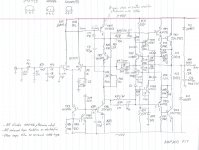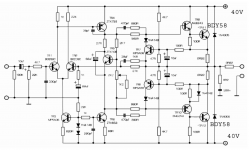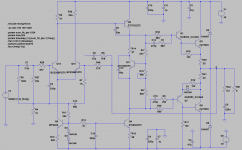some reading : Just one thing about music - when it hits you feel no pain
in "more naim stuff"
mine is a nap 90/140
in "more naim stuff"
mine is a nap 90/140
nothing to correct for me, just the schema naim with the components closest to the origin and well selected.
some remove the protection circuit, I left it because I do not even have a fuse on the primary...
some remove the protection circuit, I left it because I do not even have a fuse on the primary...
I think most Naimaholics say that 2000 was the year of real generational change, with the death of Julian Vereker, the founder, owner and inspiration behind Naim Audio.
The only kit out there that falls into the present generation of models is the NAP200 so using the low cost kits and the only schematic available, you'll be following the early models - simple, cheap and small but also tricky to get them quiet and performing anything like the originals.
I wouldn't even try to list mods. I can only say that they don't improve any amplifier that has been carefully tweaked to have a particular sound quality. You'll need to know more about the design than the designer to succeed there. It's probably better to just get busy with your web browser, search the topics and do some of the more sensible component upgrades before messing with the sound.
Some music : YouTube
More details on the models, parts upgrades and some mods here:
Modifying Naim Audio power amplifiers
Note that the recommended parts list includes the essential semi types but some of the info is outdated as many components are no longer available. BTW, the Acoustica pages originate from the guys at Pinkfishmedia - where Naim has a higher profile, as you'd expect with a UK based forum.
The only kit out there that falls into the present generation of models is the NAP200 so using the low cost kits and the only schematic available, you'll be following the early models - simple, cheap and small but also tricky to get them quiet and performing anything like the originals.
I wouldn't even try to list mods. I can only say that they don't improve any amplifier that has been carefully tweaked to have a particular sound quality. You'll need to know more about the design than the designer to succeed there. It's probably better to just get busy with your web browser, search the topics and do some of the more sensible component upgrades before messing with the sound.
Some music : YouTube
More details on the models, parts upgrades and some mods here:
Modifying Naim Audio power amplifiers
Note that the recommended parts list includes the essential semi types but some of the info is outdated as many components are no longer available. BTW, the Acoustica pages originate from the guys at Pinkfishmedia - where Naim has a higher profile, as you'd expect with a UK based forum.
Last edited:
Member
Joined 2009
Paid Member
low cost kits and the only schematic available,
Indeed, one can get all the schematics you like of the old designs. But this is fine since we're interested in these for our projects. There are high quality photographs of all the famous models and it's a good exercise for the constructor to trace them out. That's what I did here: TGM10 - based on NAIM by Julian Vereker
thanks Gareth for this topic of reflection about the naim circuit
and thank you Ian for making me discover the hackernap I did not know .
I'm not "armed" mathematically to really understand, but I have an excellent memory schemas and I understand the topology.
I have before me two new topic of reflection very interesting !
and thank you Ian for making me discover the hackernap I did not know .
I'm not "armed" mathematically to really understand, but I have an excellent memory schemas and I understand the topology.
I have before me two new topic of reflection very interesting !
but also tricky to get them quiet and performing anything like the originals
With 100% confidence, i can tell that i haven't heard that musicality from no where other then NAIM CLONE i have build just now, but it always comes with some artefacts 😀
And ofcourse, they are very stable design if everything is wired correctly. VERY STABLE !
Everything matters in that circuit. Lately i came across stupid things were boards sound alot better when they are loose and not tightened with the screw's.
I wont ever touch old naim circuit's after this.
yes,microphony !
Yes, i don't know what it is... but if boards are very tight then in some material i just can't stay in the room for a long 😀
The only kit out there that falls into the present generation of models is the NAP200 so using the low cost kits and the only schematic available, you'll be following the early models - simple, cheap and small but also tricky to get them quiet and performing anything like the originals.
They propably got Careful selecting components, careful soldering, visual, ICT, FCT, PBT, Burn in and finally listening...if result is disqusting... they change boards, components, re-tune it, whatever.
This topology can sound really nice.
Thats my last project of nap140
NCC200 is waiting few transistors and it will be finished.
Gainclones and STK-s are next, F1 or F5 are second 😛
Started my sims with two clone versions: Neil McBride's and Avondale's.
If anyone is interested I can upload the asc files here. Then perhaps someone can chime in what mods or changes worked, and which didn't.
None of them is particularly good in THD, particularly at 20KHz: 0.42% on McBride's, 1,13% on Avondale's.
I'll talk about this with another member that knows more than me. and also has been using a NAP140 clone for some time.
If anyone is interested I can upload the asc files here. Then perhaps someone can chime in what mods or changes worked, and which didn't.
None of them is particularly good in THD, particularly at 20KHz: 0.42% on McBride's, 1,13% on Avondale's.
I'll talk about this with another member that knows more than me. and also has been using a NAP140 clone for some time.
I am having some difficulty identifying the original schematic, or which combination had more approval from users here.
You would need to follow the thread (at least the on-topic posts over the last couple of years) to find most everything that has been discussed about the the NAP design and some obvious variations in each model over decades. There is no approved design here because this is a kit clone thread and there are issues with kit parts quality, original parts availability and their being genuine, that are more important to sound quality. That's the focus with cheap kits which are notorious for inappropriate parts selection, types and grades.
If you google "Naim schematic" or read Ebay kit details, this official looking schematic is what you find and I'm sure you've already seen it:
Free diagrams, schematics, service manuals beginning with N :: Schematics Unlimited
It is designated NAP250 and, as you read here several times, certain component values vary between models and series where the original parts specified are either obsolete or later versions are different, wrong Hfe type, not matched to some manufacturing tolerance etc. Naim were known to reject whole batches of components for various reasons, I guess it was specs that couldn't be met by selecting parts on test.
As very unconventional manufacturers, Naim did quite a bit of parts testing and selection which is expensive, so they passed that on in high ticket prices. I looked at pics on the internet to determine the correct component values for NAP 140 and I already had experience with repairing other models where I realised there were ongoing variations and in all models. That means, for critical functions, it's an undisclosed specification you need to match, not just a part number.
Bigun discussed parts selections for his take on the NAP140 and as his choices were quite different in some respects. It will be worth your while reading his TGM 10 thread to identify the design choices that mattered in his view.
For a more recent model with schematic taken direct from the PCB, read the posts about NAP200 and locate algar_emi's reverse-engineed schematic. That will give you known, good quality sound that has been verified by a few builders here. I did so and I'm very happy with the Caowei kit build which came with the correct parts types and only needed a few more to get a match for minimal DC offset. That's the way to go, if you want original 🙂
I doubt that anyone just following that NAP250 schematic or any other would be rewarded with Naim sound quality. Most likely, a straight design copy or kit build will sound unspectacular - mixed quality and like many generic models from the 1970s. However, you can start to correct it by calculating bias currents for TR3, TR6. From that you can adjust the emitter resistor values for your particular rail voltages accordingly. NAP 140 had 34V, not 40V regulated rails as shown so there are some minor changes to make already. The next step is to secure the most appropriate transistor types, Hfe ranges, matches and substitutes. That is a long topic and I don't plan on cranking through every possible option again myself, when its been covered in this thread a few times.
If you google "Naim schematic" or read Ebay kit details, this official looking schematic is what you find and I'm sure you've already seen it:
Free diagrams, schematics, service manuals beginning with N :: Schematics Unlimited
It is designated NAP250 and, as you read here several times, certain component values vary between models and series where the original parts specified are either obsolete or later versions are different, wrong Hfe type, not matched to some manufacturing tolerance etc. Naim were known to reject whole batches of components for various reasons, I guess it was specs that couldn't be met by selecting parts on test.
As very unconventional manufacturers, Naim did quite a bit of parts testing and selection which is expensive, so they passed that on in high ticket prices. I looked at pics on the internet to determine the correct component values for NAP 140 and I already had experience with repairing other models where I realised there were ongoing variations and in all models. That means, for critical functions, it's an undisclosed specification you need to match, not just a part number.
Bigun discussed parts selections for his take on the NAP140 and as his choices were quite different in some respects. It will be worth your while reading his TGM 10 thread to identify the design choices that mattered in his view.
For a more recent model with schematic taken direct from the PCB, read the posts about NAP200 and locate algar_emi's reverse-engineed schematic. That will give you known, good quality sound that has been verified by a few builders here. I did so and I'm very happy with the Caowei kit build which came with the correct parts types and only needed a few more to get a match for minimal DC offset. That's the way to go, if you want original 🙂
I doubt that anyone just following that NAP250 schematic or any other would be rewarded with Naim sound quality. Most likely, a straight design copy or kit build will sound unspectacular - mixed quality and like many generic models from the 1970s. However, you can start to correct it by calculating bias currents for TR3, TR6. From that you can adjust the emitter resistor values for your particular rail voltages accordingly. NAP 140 had 34V, not 40V regulated rails as shown so there are some minor changes to make already. The next step is to secure the most appropriate transistor types, Hfe ranges, matches and substitutes. That is a long topic and I don't plan on cranking through every possible option again myself, when its been covered in this thread a few times.
That's a good plan 🙂 I'd thought about this for some time too but not sure what components were used in the critical locations. I haven't seen an actual NAP160 for years so perhaps a search through pics would help.
i think too 🙂That's a good plan 🙂 I haven't seen an actual NAP160 for years so perhaps a search through pics would help.
Later on I will sim that hand written NCC200.
For now I am uploading the NAP250 simulation I did, using the Schematics Unlimited circuit.
The only component I did not have a model for were the output transistors, so I used the MJ15003.
You may note that I did not connect the cap + resistor compensation over R46. That is because the circuit oscillates on the LTP, increasing distortion.
20KHz THD is still a bit high at 78W: 0.33% Certainly it's lower at 1W.
If anyone made other sims and got different results, please chime in.
I can't seem to run AC bode plots, which I'd like to see. Don't know why.
For now I am uploading the NAP250 simulation I did, using the Schematics Unlimited circuit.
The only component I did not have a model for were the output transistors, so I used the MJ15003.
You may note that I did not connect the cap + resistor compensation over R46. That is because the circuit oscillates on the LTP, increasing distortion.
20KHz THD is still a bit high at 78W: 0.33% Certainly it's lower at 1W.
If anyone made other sims and got different results, please chime in.
I can't seem to run AC bode plots, which I'd like to see. Don't know why.
Attachments
A problem with simulations is that models aren't available for all the semis and their variations that were originally used. It is pointless simulating something using an arbitrary set of substitutes only because that's the nearest models you can find. The BC239C was selected because it had the highest guaranteed Hfe of 400-600 and I suspect parts even from that high range, were still selected on test. I understand that 2N5089 (selected on test) is a reasonable substitute for the LTP. The output transistor type has been several different types but never the slow Motorola audio types. Try an LAPT like 2SC2922 or On Semi NJW3281, MJL3281 etc.
To give an expected area for THD, even the Nait 2 (entry level integrated model) measures below 0.02% in the real world.
Check this. Go to More Naim stuff > Bias settings in Naim amps, here: Just one thing about music - when it hits you feel no pain
To give an expected area for THD, even the Nait 2 (entry level integrated model) measures below 0.02% in the real world.
Check this. Go to More Naim stuff > Bias settings in Naim amps, here: Just one thing about music - when it hits you feel no pain
Well, I think I will give up.
The THD results I get, even at 1W, are much higher than those in that site.
If someone has simulated the Naim with better results, now it's a good time to show them.
Same thing for the NAP 200 circuit above.
The THD results I get, even at 1W, are much higher than those in that site.
If someone has simulated the Naim with better results, now it's a good time to show them.
Same thing for the NAP 200 circuit above.
- Home
- Amplifiers
- Solid State
- NAP-140 Clone Amp Kit on eBay


